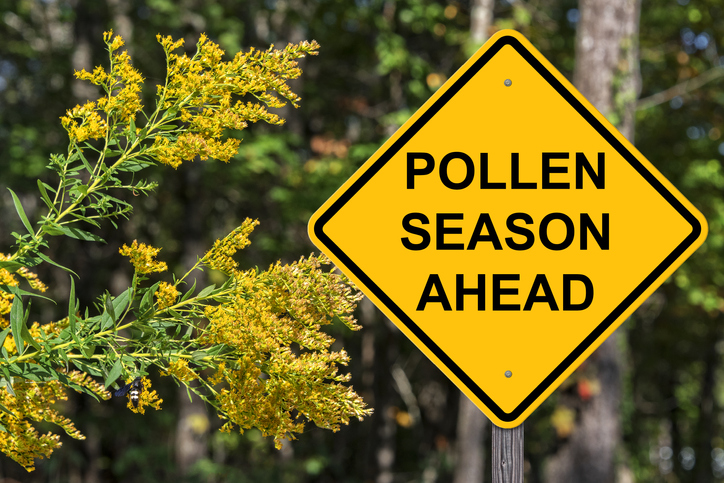
Learn About Common Triggers and Their Solutions
For many, fall seasonal allergies are just as problematic as their earlier-in-the-year counterparts. While the spring months are most often associated with the sneezing and watery eyes that come with sensitive reactions to pollen and other spring allergies, those reactions are prevalent for many sufferers in the early to mid-fall months as well — starting in August and running through October.
When dealing with seasonal allergies — in the spring or fall — it’s important to note that your immune system is trying to fight off an irritant (pollen for instance) that you’re sensitive to by releasing histamine, which leads to the unpleasant symptoms, according to the Asthma and Allergy Foundation of America (AAFA). Most of these symptoms will be the same in the spring or fall and include many associated with the common cold or the flu. However, if you have a fever it’s a sign you’re suffering from something other than a fall seasonal allergy. The symptoms are familiar for long-time allergy sufferers and include:
- Watery, itchy, or irritated eyes
- Runny nose or nasal congestion
- Sneezing
- Headaches
- A rash or hives on the skin
- Itchy throat
- Aggravated asthma symptoms like coughing or wheezing
- Trouble breathing or anaphylaxis (in extreme cases)
Today, we’ll outline some of the most common triggers for fall seasonal allergies and list a few ways you can help mitigate exposure to these triggers and gain relief from the symptoms if they occur.
Common Fall Seasonal Allergy Triggers
The most common triggers for allergies in the fall can be placed in three categories: ragweed, hay fever, and molds.
Ragweed — The biggest allergy trigger in the fall, it usually starts to release pollen with the cool nights and warm days in August. Its effects can be felt through October and into November in some parts of the country. Peak pollen levels for ragweed often come in mid-September.
About 75% of people who have spring allergies also have reactions to ragweed. And even if it is not prevalent in your area, you can still be affected. Just one ragweed plant can produce up to one billion pollen grains, and ragweed pollen can travel hundreds of miles on the wind — particularly in the eastern and midwestern regions of the country, according to the AAFA.
Hay Fever — Also known as allergic rhinitis, this condition affects between 40 and 60 million Americans each year. Technically, reactions to ragweed fall under this umbrella but those plants aren’t the only cause of hay fever during the late summer and early fall period. Warm weather can make hay fever symptoms last longer, and wet weather can spur on the growth of weeds that add to the pollen count.
Other troublesome fall seasonal allergy contributors include goldenrod, sagebrush, mugwort, cocklebur, pigweed, tumbleweed, and burning brush. The end of hay fever season often comes with the first hard freeze of the year.
Mold — Another strong fall trigger, mold can sometimes be found in the damp areas of your house — like your basement or bathroom — but also loves wet spots in the outdoors as well. Piles of damp leaves are ideal breeding grounds for mold, and the fall months bring endless piles of leaves.
Raking leaves, or stirring up those big piles kids and pets love jumping into, can agitate mold (and pollen) into the air aggravating allergy symptoms. Those with particularly troublesome allergic reactions are advised to wear a NIOSH-rated N95 mask when dealing with leaving, mowing the yard, and gardening during the fall season.
Dealing with Fall Seasonal Allergies
The Mayo Clinic has provided a substantial list of ways you can help manage, or curtail, your allergic reactions to these common triggers during the fall months.
- Limit your time outdoors on dry, windy days which will stir up and distribute troublesome pollen. The best time to go outside is after a good rain, which clears the air.
- Change clothes you’ve worn outside for a substantial time, and shower to rinse pollen from your skin and hair.
- Close doors and windows at night, or any other time when pollen counts are high.
- Plan outdoor activities at times other than in the early morning when pollen counts are highest.
- Consider delegating lawn chores like weed pulling and raking leaves that stir up allergies if you can.
Lakeview Pharmacy can offer more help in dealing with fall seasonal allergies. There are a host of over-the-counter medicines available to help treat the symptoms, but for stronger reactions, you should consider treatment-oriented and preventative supplements as a potential solution.
For example, Lakeview Pharmacy has recently partnered with Ortho Molecular Products, which combines evidence-based formulations and superior raw ingredients to develop efficacious supplements that help patients get better faster. Foremost among the Ortho Molecular products available for fall seasonal allergy relief is Natural D-Hist®, which supports nasal and sinus passageways for those who anticipate or suffer from seasonal changes.
With a targeted blend of flavonoids, antioxidants, proteolytic enzymes, and botanicals, Natural D-Hist provides comprehensive support for challenges posed by common seasonal environmental allergens. The supplement contains quercetin (flavonoid) to promote healthy histamine levels, and bromelain to support mucosal tissue health and quercetin absorption. Vitamin C and stinging nettles leaf strengthen and balance hyper-immune response, and N-acetyl cysteine clears airways by promoting normal viscosity of mucus. The combination of ingredients helps those dealing with elevated histamine levels and respiratory irritation from fall seasonal allergies.
Lakeview Pharmacy Has the Solutions You Need
The Ortho Molecular Products line is just one of many ways in which Lakeview Pharmacy is delivering innovative solutions to the problems our patients and customers face every day. With a slate of compounding services and other specialty products available, we’ll continue to do whatever it takes to serve you better.
Contact us today to learn more about Natural D-Hist and other helpful answers in dealing with fall seasonal allergies.
